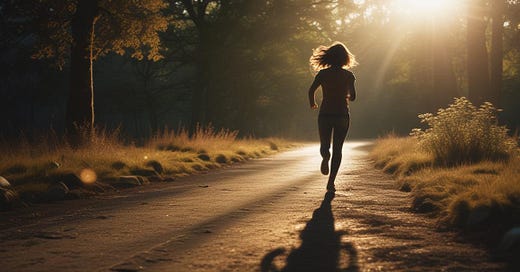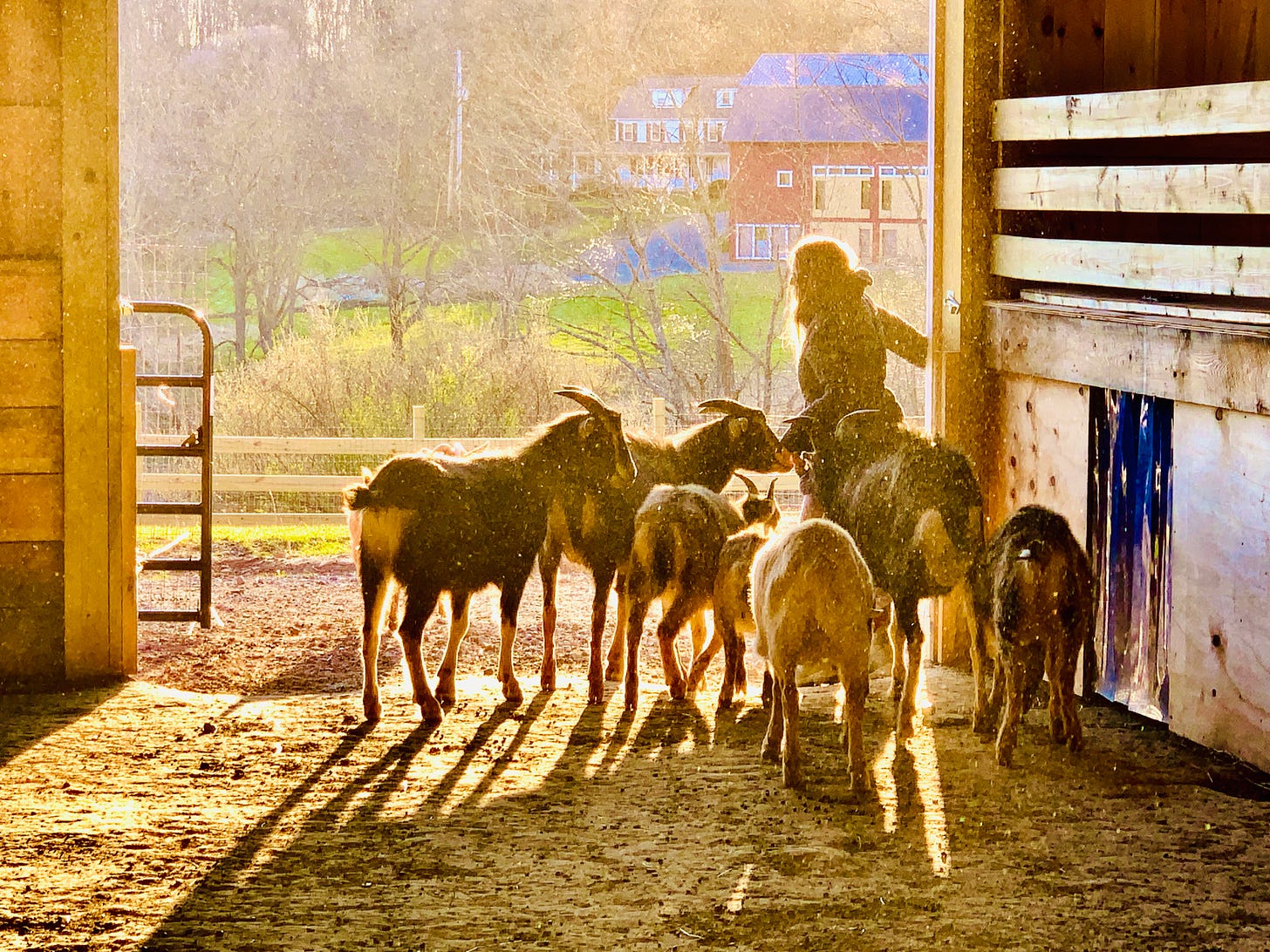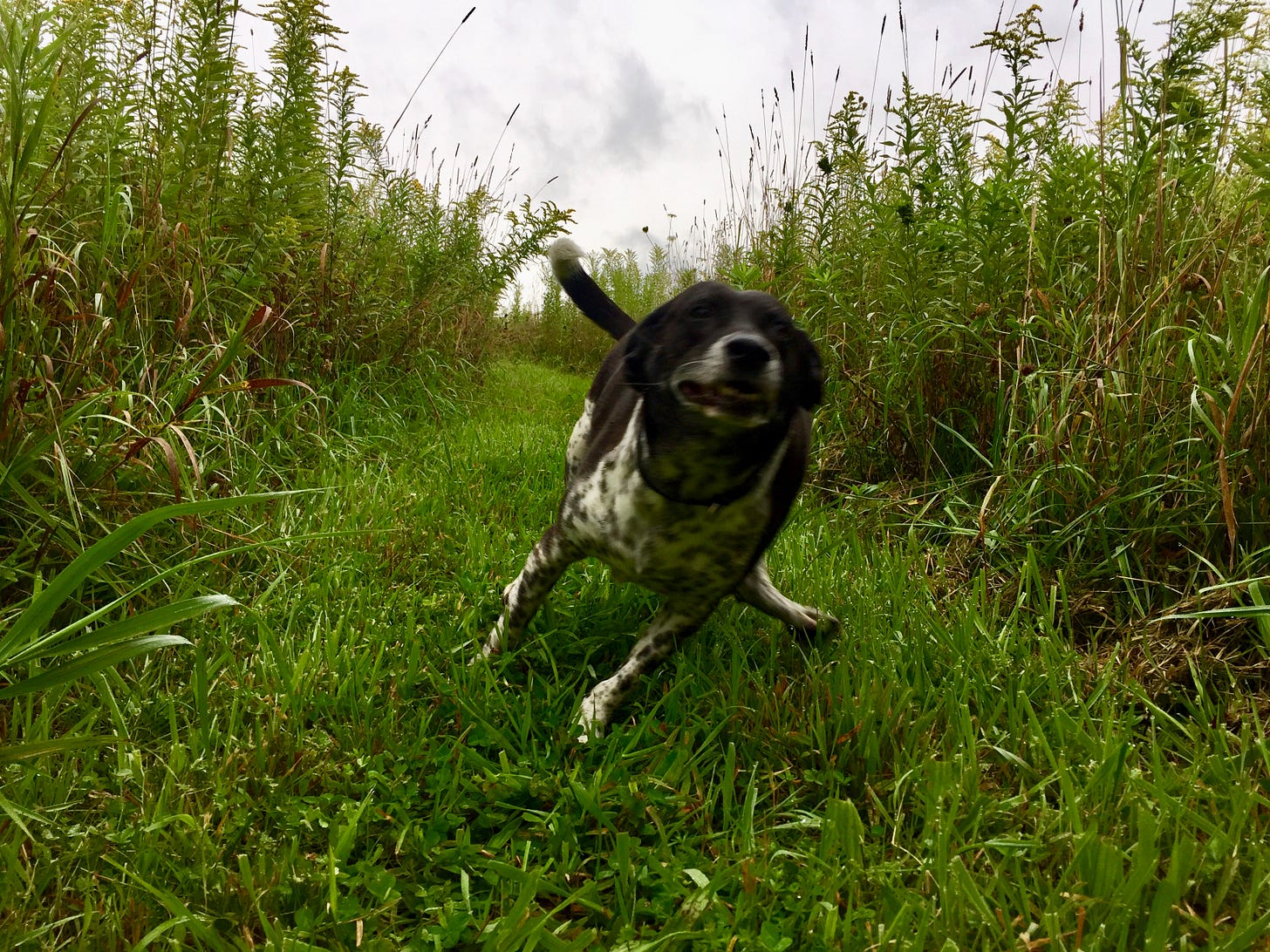When I moved to Mehoopany and founded Indraloka, I was running for my life.
My marriage was unhealthy. My friendships were unhealthy. Then I started an affair with a man who was much worse for me than my husband. My husband’s broken heart sent him spiraling to his own dark place. He fell back into his mental illness and started acting out in all kinds of crazy ways, eventually ending up with two drunk driving incidents in one night.
In the house I was moving from, I had a huge bathtub, and took to drinking wine and taking Xanax, and sometimes Ultram as well, while laying in the tub for hours every evening. My old friend Adam phoned me every night to make sure I didn’t drown.
The house was on a sharp turn on a road that lots of people used when they wanted to avoid the highway, and over the years we had several people crash into the fence and even the house itself once.
One evening after dark, I went to get the mail from the mailbox. A truck was flying towards me. I stood staring at the headlights, wishing it would run me over. My very next thought was, “But who would feed the animals?” And I quickly stepped out of the way.
The experience shook me, though. I knew I had to get healthy or I’d die soon, whether by my own hand or at the mercy of the next man I fell in love with. I knew I had a purpose in the animals and sharing their stories, so I knew I had to survive. I decided that making a fresh start was the best thing for me, and we needed to sell the house anyway, in order to move the divorce forward.
I fell in love with a place in the Endless Mountains of rural Pennsylvania. Thirty acres of rolling, hilly green pastures, four barns, a huge, beautiful creek, and a sweet little farmhouse. This was to be the home of Indraloka for the next 15 years.
I promised myself I’d get healthy. I’d had therapists over the years, but not since college had I found one I really connected with. So, I decided I had to do it on my own. The animals needed me.
New Beginning
In the beginning, it was really hard. I was trying to form new habits of mind— to keep the unhealthy thoughts at bay and manage my emotions in a healthy way. I read the Dalai Lama’s The Art of Happiness, and felt such freedom at the idea that we can re-train our minds, and his assurances that all of us will most certainly experience misfortunes in life, all of us suffer, but we can learn to be happy anyways.
I journaled and said affirmations and used guided meditations daily. I took long walks and spent almost all of my time with the animals.
I was in such a strange, dark yet hopeful place in those early days. I stopped returning calls from clients and friends. I cut everyone out of my life but Ogemaa (my elderly Medicine Man friend), Adam (my best friend from childhood), and Anne (a woman then in her 90’s that I was very close with through my 30’s until she died). However, I only spoke with them infrequently.
For the first six months, with the exception of the people I had to talk to — my divorce lawyer, the vet and farrier and occasional farm hands, and only those clients I absolutely needed to stay afloat — I did not speak at all. I couldn’t even bear to listen to music with words. I craved total silence from the human realm.
Those were sweet times in a lot of ways, and despite the hardships. I learned much from the animals, as we all lived quietly together. I started noticing more subtle things. As the human world’s noise died down inside my mind, I started noticing so many more sounds. Squirrels chittering to one another in the trees…the breeze rustling through the grass…the sigh of a horse that lets me know they are content…the quiet, not-quite-audible noise that sheep make when they wish to alert flock mates of an upcoming change in their grazing direction.
My deepened listening skills had a profound impact on my relationships with the animals. It wasn’t just sounds I was noticing. I noticed the animals’ body language, and how they communicated with one another through subtle shifts in the ways that they held their bodies or moved their heads, ears, or eyes.
In those days, I had a huge white rooster who was aptly named Big Boy. He stood nearly to my knees and was about twice the weight of most roosters you have likely met before. We took to sharing a snack of roasted sunflower seeds each day. And one day, I heard him crow before he made a sound. I was so tuned in to him that I recognized the specific type of inhalation he took before crowing.
Boomer was another beloved to whom I grew closer as a result of these months of solitude. When I met him, Boomer was an emaciated, elderly horse suffering from Poll Evil, a deep, stubborn infection in his head. He had a golden coat and mane with big, brown eyes. Treating his condition involved surgery and months of wound care and medications, so we grew very close during that time, and then closer still later, when we lived silently together in Mehoopany during those early days. We took long walks around the property sided by side, and often watched the sunset together. I found, having given up words, Boomer and I had much deeper discussions.
Of course, there were days when the weight of my past felt unbearable, when memories of my tumultuous childhood, destroyed marriage and the destructive affair would flood back. On those days, I would take my two young pigs, Duncan and Nugget, for a walk to the creek. There, I found solace, where the rhythmic flow of the water and the playful piglets swimming would gradually ease my mind. It was in those tranquil moments that I felt the true power of nature and the animals in healing my soul.
I noticed that when I spent time with the animals as they grazed, my breath lengthened, and got deeper. I noticed how newly rescued animals each had their own arc of releasing past pain and embracing present joy, and found I could see when that healing occurred by the changed look in their eyes, the ways that they breathed, and the ways in which they moved.
And I noticed that many of them had histories of abuse and trauma much worse than my own, yet each, in their own time and their own way, found their path through the darkness to embrace love and their new sanctuary life. They also taught me that I could help them to heal. The key was never to push. I just simply made sure they were safe and gave them as much freedom as I possibly could. I realized that what they needed was what I needed. A sense of empowerment over my own body and my own life. Safety. Trustworthy and gentle, patient friends. And quiet and space to heal.
A duck was brought to me by an animal rights activist, who had found him cowering behind a garbage can in the back of a live market. Tawny eyes looked back at me fearfully from behind chocolate brown feathers. I named him Abhay, which means fearless. His heart was pounding so hard, I could practically see his chest moving. Abhay wasn’t just afraid of me. He was afraid of all of the other animals, and I often found him hiding in corners of the barn. I thought about how my breathing changed when I spent time with the animals, and wondered if I could help him in the same way. So, I started spending 10 minutes or so at a time, a few times a day, simply holding his heart against mine while I breathed slowly and deeply. As Abhay grew calmer, he began to make friends with some of the other ducks and geese. When he started swimming in the pond with them, I knew he would be okay.
Something inside me began to shift. I felt a new me emerging. Tentatively, but with hope.
I knew from my exposure to my ex-husband’s medical education that Xanax was physically addictive, and quitting abruptly could cause me to have seizures. I devised my own step down schedule and weaned myself off. I was sleeping better than ever, and had few flashbacks.
I enrolled in yoga classes, joined a writer’s group, and found a massage therapist. I started making friends.
As I reflect on my journey, I realize that the sanctuary is more than just a haven for rescued animals; it’s a place where broken beings find healing together. The animals, with their silent strength and gentle presence, taught me that recovery is a shared experience. Their stories of survival and resilience mirrored my own, showing me that no matter how deep the wounds, there is always a path to healing.
Discussion: The Science Behind Healing with Rescued Farm Animals
At Indraloka, our programs designed to help people transcend trauma are called Indraloka Heals. Because the bond between humans and animals transcends traditional therapy, Indraloka Heals offers profound opportunities for mutual growth and healing. The science backs our experiences. Numerous studies reveal the powerful interactions between people and animals.
Animal-Assisted Interventions: A Healing Paradigm
Animal-Assisted Interventions (AAIs) have ancient roots, with animals seen as spiritual guides and companions. Modern research supports that interactions with animals can significantly improve human well-being by reducing stress, anxiety, and depression (O’Haire et al., 2015; Mims, 2019; Gorman and Cacciatore, 2023).
In regions like ours, marked by generational trauma, AAIs offer a promising solution. The area’s history of poverty and social marginalization has left a legacy of trauma. AAIs provide accessible, non-stigmatizing therapy, aligning with global health goals for community-focused interventions.
How Animals Help the Brain Heal
Trauma affects core brain functions, particularly the amygdala, hippocampus, and prefrontal cortex. Engaging with animals helps regulate the amygdala, reducing the “fight or flight” response, and supports the hippocampus in distinguishing between past and present memories (Nakamura et al., 2018; Smith et al., 2019). This interaction fosters a safe environment for expressing emotions and rebuilding trust.
Building Community and Overcoming Isolation
AAIs provide therapy and help build community. Engaging with animals breaks down social barriers, alleviating the isolation often felt by trauma survivors. In a region marked by generational trauma, AAIs serve as a beacon of hope, demonstrating the power of human-animal bonds.
Human-Animal Resonance
Participants describe a profound sense of connection with animals. This bond is more than therapeutic; it is a shared experience of compassion and trust. Animals with traumatic pasts serve as symbols of resilience, inspiring participants to cope with their own pain and fostering a mutual journey of healing (Gorman and Cacciatore, 2022; Ferdowsian and Merskin, 2012).
Living in the Present
Indraloka Heals grounds individuals in the present, offering a stable environment where past traumas are met with the reassuring presence of animals. This shared space allows both humans and animals to find respite and connection, highlighting the universal need for love and touch.
Ethical Considerations and Mutual Benefit
Animals are not just therapy tools but distinct beings with unique histories. Ethical care practices are crucial, especially when integrating rescued animals into therapeutic contexts. Recognizing the mutual benefits, our research shows that both nonhuman animals and human animals flourish in this setting, fostering a multi-species approach to healing (Iannuzzi and Rowan, 1991; Gorman, 2019a).
Conclusion & Benediction
The symbiotic relationship between humans and rescued farm animals provides a unique and powerful avenue for trauma recovery, illustrating the profound potential of mutual well-being and resilience.
If you are feeling the weight of your past or the burdens of trauma, remember that healing is not just a possibility—it is a journey you can embark on today. The path to recovery is often lined with unexpected allies and moments of profound connection, many of which can be found in the gentle presence of animals.
Imagine the tranquility of standing in a peaceful pasture, the comforting rhythm of animal heartbeats against your own, and the silent wisdom found in the eyes of a horse or the soft nuzzle of a sheep. These moments are more than therapeutic; they are life-changing. They remind us that, like the animals who have endured and overcome, we too possess the strength to heal and thrive.
Seek out a farm animal sanctuary near you. These places offer not just refuge for animals but sanctuaries of hope and healing for people. There, you can experience firsthand the incredible bond that forms between humans and animals, a bond that transcends words and taps into the deepest parts of our humanity.
Take that first step towards your own healing. Allow yourself the grace to find solace and strength in the company of animals. Embrace the silence, listen to their stories with your soul, and share in the journey of mutual recovery. Remember, no matter how deep your wounds, there is always a path to healing, illuminated by the shared experiences of resilience and love.
In these shared spaces, broken beings—both human and animal—find healing together. And as you transcend your past, you contribute to a circle of compassion that helps others find their way out of the darkness. This journey is not just about finding peace for yourself; it’s about creating a world where all beings can experience the profound joy of healing and connection.
Start your journey today. Find a sanctuary. Open your heart. Heal together.
Join the Conversation
What parts of this essay resonate with you? Have you ever made friends with a rescued farm animal? Have you ever experienced sustained silence? What parts of this article do not resonate, and why? What is your advice for others seeking healing? Please share in the comments below.
References
Ferdowsian, H., & Merskin, D. (2012). Parallels in sources of trauma, pain, distress, and suffering in humans and nonhuman animals. Journal of Trauma & Dissociation, 13(4), 448–468. https://doi. org/10.1080/15299732.2011.652346
Gorman, R. Cacciatore, J. (2022): Exploring the Effects of the Human–Animal Relationship on Care-Farms in the Context of Trauma Histories, Anthrozoös, DOI: 10.1080/08927936.2022.2084995
Gorman, R. (2019a). Thinking critically about health and human–animal relations: Therapeutic affect within spaces of care farming. Social Science & Medicine, 231, 6–12. https://doi.org/10.1016/j.socscimed.2017.11.047
Gorman, R. (2019b). What’s in it for the animals? Symbiotically considering “therapeutic” human–animal relations within spaces and practices of care farming. Medical Humanities, 45(3), 313–325. https://doi.org/10.1136/medhum-2018-011627
Iannuzzi, D., & Rowan, A. N. (1991). Ethical issues in animal-assisted therapy programs. Anthrozoös, 4 (3), 154–163. https://doi.org/10.2752/089279391787057116
Mims, D. (2019, February 23). Animal Assisted Therapy and Trauma Survivors. Acta Scientific. Retrieved June 9, 2023, fromhttp://www.actascientific.com/ASNE/pdf/ASNE 02-0026.pdf
O'Haire, M. E., Guérin, N. A., & Kirkham, A. C. (2015). Animal-Assisted Intervention for trauma: a systematic literature review. Frontiers in psychology, 6, 1121 https://doi.org/10.3389/fpsyg.2015.01121
Richard Gorman & Joanne Cacciatore (2023) Exploring the Effects of the Human-Animal Relationship on Care-Farms in the Context of Trauma Histories, Anthrozoös, 36:2, 163-177, DOI: 10.1080/08927936.2022.2084995
Nakamura, K., Takimoto-Inose, A., & Hasegawa, T. (2018). Cross-modal perception of human emotion in domestic horses (Equus caballus). Scientific reports, 8(1), 8660. https://doi.org/10.1038/s41598-018-26892-6
Smith, A. V., Proops, L., Grounds, K., Wathan, J., & McComb, K. (2016). Functionally relevant responses to human facial expressions of emotion in the domestic horse (Equus caballus). Biology letters, 12(2), 20150907. https://doi.org/10.1098/rsbl.2015.0907







Thank you for sharing. Very powerful stuff. We volunteer locally at a sanctuary and find it very restful and healing